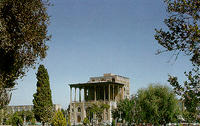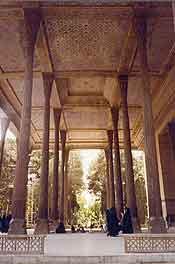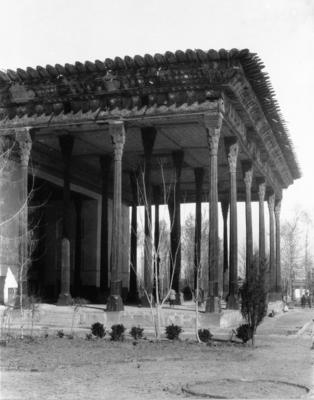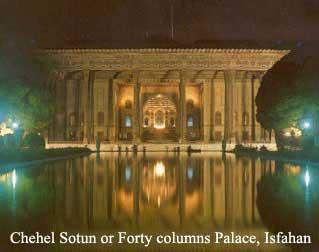Latest Pictures From Sari, Mazandaran, Iran
 A Photo Essay: Chenars of Sari
A Photo Essay: Chenars of Sari
Here in this webpage we already had articles about old Chenars and references to old chenars in the city of Sari:
"In fact many recorded old planes (Chenars) are located near the shrine of an Emam-zadeh, at or near a masque, a Takieh, an old cemetery, or similar “sacred” places.
For instance the 220 years old (20m high) plane at Emamzadeh Abbas and 140 years old (20m high) plane at Pir Takieh in Sari, northern province of Mazandaran. ..."
http://chenarestan.blogspot.com/2005/08/home-of-oriental-plane-tree-part-iii.html

 My dear old friend Reza Tahmasbi, architect and planner, visited Iran last month and sent pictures from Chenars in the city of Sari, his hometown.
My dear old friend Reza Tahmasbi, architect and planner, visited Iran last month and sent pictures from Chenars in the city of Sari, his hometown.
The pictures above and on the left are from Emamzadeh Abbas Chenar.
Unfortunately, he couldn't see the Pir-Takieh Chenar. Apparently it doesn't exist anymore.

Left: Picture of old Chenar in Chal-e Masjed
neigbourhood, downtownSari.

Left: Khayyam Ave.
Sari

Left:
Farhang Ave.
Sari
 A new meaningless trend:
A new meaningless trend:
Artificial elecrtronic trees..!  How Many "Sari"s do we have?
How Many "Sari"s do we have?
Before publishing this essay, I searched for the name Sari. I found about 75 names. I could zoom in on the maps for any of locations.
I was surprised when I realized that most of those names refer to places outside Mazandaran provnce. they located in northwestern provinces of Ardebil, western and eastern Azarbayjan and even on the west side of Caspian see in todays Azarbayjan Republic, in Kerman, Khuzestan or Hamedan......
In any pages below there is a list of places, with clicking on each name the map appears and you can zoom in.
http://www.indexmundi.com/zp/ir/55660.htmhttp://www.indexmundi.com/zp/ir/55680.htmhttp://www.indexmundi.com/zp/ir/55700.htmhttp://www.indexmundi.com/zp/ir/55720.htmhttp://www.indexmundi.com/zp/ir/55740.htmFor more information on plane tree (chenar) in Iran read the articles "Home of Oriental Plane Tree" --Siamak D. Ahi
Home of Oriental Plane Tree Part IV  Chenar Wood in Building and Carpentry*Plane (Chenar) wood is lightweight, hard (but easy to plane), with an attractive texture. It constitutes the main carpentry material in most non-wooded areas of the country, for instance in Isfahan, the farmers call it Mikh-e Tala-ee (golden peg) . Nowadays it is frequently used to make chests, doors, windows, parquet, veneer, etc.
Chenar Wood in Building and Carpentry*Plane (Chenar) wood is lightweight, hard (but easy to plane), with an attractive texture. It constitutes the main carpentry material in most non-wooded areas of the country, for instance in Isfahan, the farmers call it Mikh-e Tala-ee (golden peg) . Nowadays it is frequently used to make chests, doors, windows, parquet, veneer, etc. Above: Aali Ghapoo Palace
Above: Aali Ghapoo Palace
Adam Olearius, the member of the embassy sent by Duke of Holstein-Gottorp to the Safavid court in Isfahan during the first half of 17th (11th) century , when writing about Persian decorative woodwork, reports that Persians “like specially a kind of wood , unknown in Europe, called Tzinar (i.e., Chenar)….It is brown and has a wavy grain, and the Persian use it for doors and windows, which, when rubbed with oil, become incomparably finer than those made here (I.e. Europe) of walnut.”
Below: Chehel Sotun Palace
 The wooden columns in the former royal Safavid palaces Aali Ghapoo and Chehel Sotun in Isfahan (both built in first half of 11th century), are hewn out of plane logs to an average diameter of 60cm and still are holding firm in spite of severe insect damages.
The wooden columns in the former royal Safavid palaces Aali Ghapoo and Chehel Sotun in Isfahan (both built in first half of 11th century), are hewn out of plane logs to an average diameter of 60cm and still are holding firm in spite of severe insect damages.
Plane wood, usually obtained by pollarding the planes, is also used as fairly good fuel in some rural areas. (for individual presentation of plane in Persian painting, see Survey of Persian art XV, index, p.47, s.v. Plane trees)


Chenar Tree in Proverbs
For literary allusion to plane fire, in Dehkhoda dictionary we can read the proverb “ the plane fire is from the plane itself” and Farid-al-din Attar’s distich; “Every silkworm clothes itself with shroud, every plane tree ignites fire from itself.”
The statement by some Persian poet and lexicographers that “the plane is known to catch fire by itself” may have its explanation in flammability of dry plane wood: As in the primitive fire-making method of generating heat and then fire by the friction of two wooden objects, the dried spreading branches of an old plane rubbing together in the wind. Specially in dry weather may produce smoke or ignite fire from itself. Some of the above-mentioned “burnt planes” may have suffered from this phenomenon.

Fourty Colunm Palace has actually twenty columns. The name counts also their reflection in the pond.*) Note:The "Home of Oriental Plane Tree" parts, which comes with different titles, are taken from Encyclopaedia Iranica. The references and notes of original text are deleted, titles and subtitles are added to provide easy to read articles. For further study you can use http//www.Iranica.com --Siamak D. AhiPrevious Parts:Home of Oriental Plane Tree, Part Ihttp://chenarestan.blogspot.com/2005/07/home-of-oriental-plane-tree.htmlOriental Plane Tree and Healing, Part IIhttp://chenarestan.blogspot.com/2005/07/home-of-oriental-plane-tree-part-ii.htmlVeneration of Old Trees, Part IIIhttp://chenarestan.blogspot.com/2005/08/home-of-oriental-plane-tree-part-iii.html
 A Photo Essay:
A Photo Essay: 
 My dear old friend Reza Tahmasbi, architect and planner, visited Iran last month and sent pictures from Chenars in the city of Sari, his hometown.
My dear old friend Reza Tahmasbi, architect and planner, visited Iran last month and sent pictures from Chenars in the city of Sari, his hometown.


 A new meaningless trend:
A new meaningless trend:






